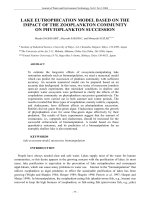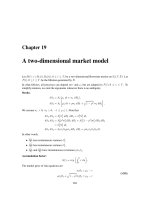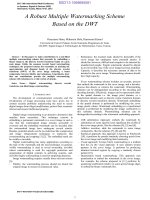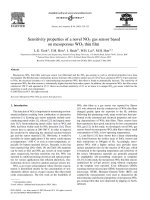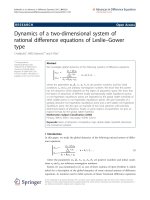Development of a two dimensional wave model based on the extended boussinesq equations
Bạn đang xem bản rút gọn của tài liệu. Xem và tải ngay bản đầy đủ của tài liệu tại đây (1.59 MB, 121 trang )
DEVELOPMENT OF A TWO-DIMENSIONAL WAVE MODEL
BASED ON THE EXTENDED BOUSSINESQ EQUATIONS
MAN CHUANJIAN
NATIONAL UNIVERSITY OF SINGAPORE
2003
i
DEVELOPMENT OF A TWO-DIMENSIONAL WAVE MODEL
BASED ON THE EXTENDED BOUSSINESQ EQUATIONS
MAN CHUANJIAN
(B. Eng., Tsinghua)
A THESIS SUBMITTED
FOR THE DEGREE OF MASTER OF ENGINEERING
DEPARTMENT OF CIVL ENGINEERING
NATIONAL UNIVERSITY OF SINGAPORE
2003
Acknowledgement
I would like to take this opportunity to express my sincere gratitude and appreciation
to my supervisor Dr. Lin PengZhi for his keen guidance, encouragement, invaluable
advice and endless support during the course of this work. I am highly indebted to my
supervisor for his personal care and affection and for making my stay in Singapore a
memorable experience.
I am thankful for the financial support of a research scholarship provided by the
National University of Singapore. Additionally, I would like to give my appreciation
to the staff of the Hydraulics Laboratory for their technical assistance and to my
colleagues for their advice and support.
I also owe gratitude to the thesis examiners for their helpful suggestions to improve
the thesis.
Last but not least, I would like to express my gratitude to my wife Shi Meng for her
steadfast support and encouragement.
i
ABSTRACT
The extended Boussinesq equations by Nwogu (1993) are suitable to simulate wave
propagation from relative deep to shallow water. The equations contain all shoaling,
refraction, diffraction and reflection effects in a variable depth. As a compromise
between the theoretical accuracy of the mathematical model and the efficiency of
solving the equation system numerically, Nwogu’s extended Boussinesq equations
was selected in this study.
A high-order staggered grid numerical model based on Nwogu’s two-dimensional
Boussinesq equations is developed in this thesis. The equations are solved numerically
by using a fourth order accurate predictor-corrector method. This scheme has the
conservative form for both mass and momentum. An internal wave generation method
has been incorporated into the model. Sponge layers are placed in front of the open
boundaries to absorb wave energy and minimize wave reflections.
The model can be used to simulate the evolution of relatively short and weakly
nonlinear waves in water of constant or variable depth. The performance of the
numerical model is demonstrated by comparing theoretical results, numerical results of
previously published numerical model and experimental data. The agreements are very
good. In particular, excellent results in terms of mass and energy conservation were
obtained in the numerical experiment of water sloshing in confined containers.
ii
TABLE OF CONTENTS
Acknowledgements
i
Abstract
ii
Table of Contents
iii
List of Figures
vi
Chapter 1 Introduction
1
1.1 Background of Boussinesq equations ......................................................................4
1.2 Back ground of Boussinesq numerical Model .........................................................9
1.3 Outline of the thesis ...............................................................................................11
Chapter 2 The Boussinesq Equations
13
2.1 Introduction............................................................................................................13
2.2 The mathematical formulation...............................................................................15
2.2.1 Euler’s Equation ...........................................................................................15
2.2.2 Derivation of Nwogu’s extended Boussinesq equation................................18
2.3 Linear dispersive wave theory ...............................................................................23
2.4 Dispersion characteristics of the extended Boussinesq equation...........................27
iii
Chapter 3 An Algorithm for the One-dimensional
Extended Boussinesq Equations
34
3.1 Introduction............................................................................................................34
3.2 Time integration.....................................................................................................35
3.3 The one-dimensional extended Boussinesq equation system ................................38
3.4 Spatial discretization..............................................................................................40
3.5 Boundary conditions ..............................................................................................45
3.5.1 Wavemaker Boundaries ................................................................................45
3.5.2 Reflective Boundaries...................................................................................48
3.5.3 Absorbing Boundaries ..................................................................................50
3.6 Numerical experiments ..........................................................................................52
3.6.1 A periodic wave with constant depth............................................................52
3.6.2 Linear shoaling .............................................................................................54
3.6.3 Solitary Wave Propagation over Flat Bottom...............................................55
3.6.4 Periodic wave train passing a submerged breakwater ..................................60
3.6.5 Water sloshing in a confined container.........................................................63
Chapter 4 An Algorithm for the Two-dimensional
Extended Boussinesq Equations
68
4.1 Introduction............................................................................................................68
4.2 The two-dimensional extended Boussinesq equation system................................70
4.3 Numerical Model ...................................................................................................73
4.4 Boundary conditions ..............................................................................................85
4.4.1 Wavemaker Boundaries ................................................................................85
4.4.2 Reflective Boundaries...................................................................................87
iv
4.4.3 Absorbing Boundaries ..................................................................................89
4.4.4 Internal generation of waves.........................................................................90
4.5 Numerical experiments ..........................................................................................93
4.5.1 Wave evolution in closed rectangular basin .................................................93
4.5.2 Wave focusing by a topographic lens ...........................................................98
4.5.3 Wave propagation over an elliptical shoal..................................................102
Chapter 5 conclusions
106
Bibliography
108
v
List of Figures
Fig. 2.1 Comparison of Normalized Phase Speeds for Different Values of α ..........29
Fig. 2.2 Comparison of Normalized Group Velocities for Different Values of α ....31
Fig. 2.3 Comparison of shoaling gradient between linear wave theory and extended
Boussinesq equation .....................................................................................33
Fig. 3.1 Grid points used in predictor-corrector methods ..........................................35
Fig. 3.2 Staggered grid notation in one-dimensional..................................................40
Fig. 3.3 Linear wave propagates in constant water depth............................................52
Fig.3.4 Weakly nonlinear wave propagates in constant water depth...........................53
Fig.3.5 Simulation of linear shoaling from deep water to shallow water ....................54
Fig.3.6 Spatial profile of solitary wave evolving in water of constant depth
(h=0.5m) with δ = 0.1 .....................................................................................58
Fig.3.7 Spatial profile of solitary wave evolving in water of constant depth
(h=0.5 m) with δ = 0.1 .....................................................................................59
Fig.3.8 Spatial profile of solitary wave evolving in water of constant depth
(h=0.5m) with δ = 0.3 .....................................................................................59
Fig.3.9 Experimental setup of a periodic wave train passing
a submerged breakwater ..................................................................................61
Fig.3.10 Comparisons of free surface displacement at the last eight wave gauge
locations between numerical results and experimental data breakwater .......62
Fig.3.11 Comparisons of numerical results and analytical solution for water
sloshing in a confined container in the first period........................................64
Fig.3.12 Comparisons of numerical results and analytical solution for water
sloshing in a confined container in different periods.....................................65
Fig.3.13 Comparisons of time series of relative error of water volume M..................67
Fig.4.1 Staggered grid systems ....................................................................................75
Fig. 4.2 Contour plots of surface elevation of time series ...........................................95
vi
Fig. 4.3 Spatial Profiles of Surface Elevation at time t = 0, 10, 20, 30, 40, and 50 (s) .........96
Fig.4.4 the Relative Error of Water Volume E of Time Series ...................................97
Fig.4.5 Bathymetry for wave focusing experiment .....................................................99
Figs.4.6 Lengthwise free surface elevation at t = 40 (s) ............................................100
Figs.4.7 Wave height coefficient ...............................................................................101
Figs.4.8 Perspective view of the fully-developed wave ............................................102
Figs.4.9 Bathymetry for the elliptical shoal experiment............................................104
Fig.4.10 Comparisons of amplitude along specified sections ...................................105
vii
Chapter 1
Introduction
Every coastal or ocean engineering study such as a beach nourishment project or a
harbor design planning, requires the information of wave conditions in the region of
interest. Usually, wave characteristics are collected offshore and it is necessary to
transfer these offshore data on wave heights and wave propagation direction to the
project site. The increasing demands for accurate design wave conditions and for input
data for the investigation of sediment transport and surf zone circulation have resulted
in significant advancement of wave transformation models during the last two decades
(Mei and Liu 1993).
When wind waves are generated by a distance storm, they usually consist of a wide
range of wave frequencies. The wave component with a higher wave frequency
propagates at a slower speed than those with lower wave frequencies. As they
propagate across the continental shelf towards the coast, long waves lead the wave
group and are followed by short waves. In the deep water, wind generated waves are
not affected by the bathymetry. Upon entering shoaling waters, however, they are
either refracted by bathymetry or current, or diffracted around abrupt bathymetric
features such as submarine ridges or canyons. A part of wave energy is reflected back
to the deep sea. Continuing their shoreward propagation, waves lose some of their
1
energy through dissipation near the bottom. Nevertheless, each wave profile becomes
steeper with increasing wave amplitude and decreasing wavelength. Because the wave
speed is proportional to the square root of the water depth in very shallow water, the
front face of a wave moves at a slower speed than the wave crest, causing the
overturning motion of the wave crest. Such an overturning motion usually creates a jet
of water, which falls near the base of the wave and generates a large splash.
Turbulence associated with breaking waves is responsible not only for the energy
dissipation, but also for the sediment movement in the surfzone.
In the early of 1960’s, the wave ray tracing method was a common tool for estimating
wave characteristics at a design site. Today, powerful computers have provided coastal
engineers with the opportunity to employ more sophisticated numerical models for
wave environment assessment. However, these numerical models are still based on
simplified governing equations, boundary conditions and numerical schemes,
imposing different restrictions to practical applications. The computational effort
required for solving a wave propagation problem exactly by taking all physical
processes, which involve many different temporal and spatial scales, into account is
still too large. To date, two basic kinds of numerical wave models can be distinguished:
phase-resolving models, which are based on vertically integrated, time-dependent
mass and momentum balance equations, and phase-averaged models, which are based
on a spectral energy balance equation. The application of phase-resolving models,
which require 10 ~ 100 time steps for each wave period, is still limited to relatively
small areas, o (1 ~ 10 km), while phase averaged models are more relax in the spatial
resolution and can be used in much larger regions. Moreover, none of the existing
models, phase-resolving or not, considers all physical processes involved.
2
The more recent research efforts have been focused on the development of unified
phase-resolving models, which can describe transient fully nonlinear wave
propagation from deep water to shallow water over a large area. In the meantime,
significant progress has also been made in simulating the wave-breaking process by
solving the Reynolds Averaged Navier-Stokes (RANS) equations with a turbulence
closure model. These RANS models have also been employed in the studies of wave
and structure interactions.
The purpose of this introduction is to provide a short summary of the evolution of
phase-resolving wave propagation models during the last two decades, especially
focusing on the development of Boussinesq-type equation; and the numerical schemes
of these Boussinesq equations.
3
1.1 Background of Boussinesq equations
The earliest model which is independent of the vertical coordinate, but includes
weakly dispersive and nonlinear effects, was derived by Boussinesq (1872). The
model was derived for horizontal bottom only. And this model assumes irrotationality
of the flow, parabolic vertical dependence of the horizontal velocity (or velocity
potential) and linear vertical dependence of the vertical velocity. This model, also, has
the depth averaged horizontal velocity and the free surface elevation as the dependent
variables. As an aside, in this work, we refer to Boussinesq-type (or simply
Boussinesq) models as those which assume irrotationality and that the velocity
potential (or horizontal velocity) has a polynomial vertical dependence, leading to a set
of equations governing the free surface elevation and a vertically independent
horizontal velocity-related variable (e.g. depth-averaged velocity, total mass flux,
velocity potential at the bottom, etc).
To overcome the horizontal bottom limitation in the original Boussinesq model, which
prevents the model from being a very useful tool in coastal engineering, Mei and
Mehaute (1966) and Peregrine (1967) derived Boussinesq models for variable depth.
The two models are similar in the sense that both use the same asymptotic assumptions
which are weak nonlinearity and dispersiveness. Mei and Mehaute, however, used the
velocity at the bottom as a dependent variable, whereas Peregrine used the depthaveraged velocity. Due to the wide popularity in the coastal engineering community,
the model by Peregrine (1967) is often called the standard Boussinesq model. The
4
standard Boussinesq model is able to describe the nonlinear transformation of irregular,
multidirectional waves in shallow water. Also, the standard Boussinesq model
represents the depth-integrated equations for the conservation of mass and momentum
for an incompressible and inviscid fluid. The vertical velocity is assumed to vary
linearly over the depth to reduce the three-dimensional problem to a two-dimensional
one. The model, in addition, includes the lowest-order effects of frequency dispersion
and nonlinearity. The standard Boussinesq equations can thus account for the transfer
of energy between different frequency components, changes in the shape of the
individual waves, and the evolution of the wave groups, in the shoaling of an irregular
wave train (e.g., Freilich and Guza 1984).
Although standard Boussinesq models can predict wave transformation in coastal
regions with relative accuracy, its range of validity is limited to fairly shallow water
(McCowan, 1987), since its linear dispersion relationship is only a polynomial
approximation of the exact one. To keep errors in the phase velocity less than 5%, the
water depth has to be less than about one-fifth of the equivalent deep-water
wavelength (McCowan 1987). In order to be applicable in deeper water, many authors
have suggested extending the validity of Boussinesq models. The extended Boussinesq
models have adjustable polynomial approximations for the dispersion relationship, a
major improvement over the approximation resulting from the standard Boussinesq
models. Madsen et al. (1991) and Madsen and Sorensen (1992) included higher order
terms with adjustable coefficients into standard Boussinesq equations for constant and
variable water depth, respectively. The addition of these terms resulted in a rational
polynomial expansions as the linear dispersion relationship. The coefficients were then
adjusted to give better linear shoaling coefficient and a more accurate approximation
5
to the exact linear dispersion relationship, namely, the (2, 2) Pade approximant
(witting, 1984). Like Peregrine (1967), Madsen used the depth-averaged velocity. Beji
and Nadaoka (1996) have produced an extended Boussinesq system, valid in a variable
depth environment, by a simple algebraic manipulation of Peregrine’s original system.
The consistency of the various equation systems is still being debated by Schaffer,
Madsen (1998) and Beji and Nadaoka (1998) although most recently Schaffer and
Madsen (1999) have suggested that these equation systems are all equivalent and can
be derived from a further set of extended Boussinesq equations involving an additional
free parameter (Schaffer and Madsen, 1995). In contrast, by defining the dependent
variable as the velocity at an arbitrary depth, Nwogu (1993) achieved a rational
polynomial approximation to the exact linear dispersion relationship without the need
to add higher order terms to the equations. Although the arbitrary location could be
chosen to give a (2.2) Pade approximation as the linear dispersion relationship, Nwogu
(1993) chose an alternative value which minimized the error in the linear phase speed
over some depth range. Both expressions are much closer to the exact solution in
intermediate water depths than are the standard Boussinesq equations. And, Madsen et
al. and Nwogu have shown by example that the extended equations are able to
simulate wave propagation from relative deep to shallow water.
Despite their improved dispersion relation, the extended Boussinesq equations are still
restricted to situations with weakly nonlinear interactions. In many practical cases,
however, the effects of nonlinearity are too large to be treated as a weak perturbation
to a primarily linear problem. As waves approach shore, wave height increases due to
the effect of shoaling, and wave breaking occurs on most gentle natural slopes. The
wave height to water depth ratios accompanying this physical process are
6
inappropriate for weakly nonlinear Boussinesq models, and thus extensions to the
model are required in order to obtain a computational tool which is locally valid in the
vicinity of a steep, almost breaking or breaking wave crest. Fully nonlinear models for
moderately long waves have been developed and studied for several decades. Using a
power series expansion, Su and Gardner (1969) investigated a fully nonlinear
formulation from which they are able to derive KdV and Burgers equations for a class
of nonlinear Galilean-invariant systems. Using standard perturbation methods and
depth-averaged velocity, Mei (1989) derived Boussinesq equations for constant depth
with no assumption of small nonlinearity. Perturbation methods and the theory of fluid
sheets reduce the dimensionality of the original water wave problem by one. Chen and
Liu (1995) derived a model analogous to Nwogu’s but used a velocity potential at an
arbitrary depth as the dependent variable. For regular waves propagating over a slowly
varying topography, the governing equations for the velocity potentials of each
harmonic are a set of weakly nonlinear coupled fourth-order elliptic equations with
variable coefficients. The accuracy of the parabolic approximation to a fourth-order
ordinary differential equation with a weak forcing term (which may involve the other
independent variable) depends on the difference between the wave number of the
forcing term and the characteristic wave number of the equation. Wei et al. (1995)
used Nwogu’s approach to derive a Boussinesq model (referred to henceforth as the
WKGS model) without the weak nonlinearity restriction, which is called fully
nonlinear Boussinesq model. In strongly nonlinear situations (such as wave evolution
just prior to wave breaking), the fully nonlinear Boussinesq model provides
significantly improved predictions of wave heights and internal kinematics relative to
the weakly nonlinear Boussinesq model. Numerical computations showed a major
improvement over the weakly nonlinear model of Nwogu, and compared well with
7
solitary wave solutions of the full potential problem obtained with the boundary
elements method by Grilli et al. (1989). By retaining terms of higher order in both the
frequency dispersion and the amplitude dispersion, Madsen et al. (1996) derived a new
set of Boussinesq-type equations. In order to enhance the linear dispersion
characteristics in deeper water the equations were modified using a technique
described in Schaffer and Madsen (1995). Madsen and Schaffer (1999) derived higher
order Boussinesq-type equations to improve dispersion and nonlinearity. Recently,
Gobbi et al. (2000) presented a higher-order formulation based on a linear combination
of the velocities at two arbitrary z-levels. Madsen et al. (2001) derived higher-order
equations by using arbitrary z-level. The arbitrary z-level is determined by minimizing
the depth-integrated error of the linear velocity profile. In comparison with the
standard equations all these equations involve numerous additional derivatives, hence
making a numerical solution elaborate.
8
1.2 Background of Boussinesq numerical Model
Most of the numerical schemes for the Boussinesq equations are based on finite
difference methods. Peregrine (1966) presented probably the first finite difference
method for a Boussinesq-type equation system, using second order spatial and
temporal approximations.The reported results were dissipative and accuracy was only
maintained by choosing sufficiently small mesh spacing. However, Abbot et al (1978,
1984) pioneered the finite difference solution of the original Boussinesq system for
practical engineering problems and analyzed the methods carefully to ensure accurate
solutions. Madsen et al (1991, 1992) applied extensions of these techniques in their
finite difference methods for the extended Boussinesq equation systems. The
differential equations are discretized by time-centered implicit scheme with variables
defined on a space-staggered rectangular grid. The method is based on the ADI
(Alternating Direction Implicit) algorithm, and the resulting system of finite difference
equations is reduced to a tri-diagonal system, which is solved by the Double Sweep
algorithm. The finite difference approximation of the spatial derivatives is a strait
forward mid-centering except for the nonlinear convective terms. And Nwogu (1993),
an iterative Crank-Nicolson method is employed, with predictor-corrector scheme
used to provide the initial estimate. The partial derivatives are approximated using a
forward difference scheme for the time variable and a central difference scheme for
the space variable. The numerical solution procedure involves solving an explicit
expression for η and a tridiagonal matrix for uα in the predictor and corrector stages,
and tridiagonal matrices for both variables in the iterative stage. Tridiagonal matrices
9
contain only diagonal and adjacent off-diagonal terms and can be solved efficiently
using a Gaussian elimination process.
More recently Wei and Kirby (1995) presented an alternative technique for deriving
finite difference schemes for Boussinesq-type systems and demonstrated that accurate
solutions could be obtained. Noting that the non-physical dispersion present in a
second order finite difference spatial discretisation was due only to the first order
derivative, they differenced these terms to fourth order and the dispersive terms to
second order. The system of equations is written in a form that makes the application
of a higher-order time-stepping procedure convenient. They integrated in time with a
fourth order predictor-corrector method to ensure that no more dispersive errors were
introduced. All errors involved in solving the underlying nonlinear shallow water
equations are thus reduced to 4th order in grid spacing and time step size. Spatial and
temporal differencing of the higher-order dispersion terms are done to second-order
accuracy, which again reduces the truncation errors to a size smaller than those terms
themselves. No further back-substitution of apparent truncation error terms is
performed. These finite difference methods have been used to predict wave elevations
inside harbours (A. Schroter et al. 1995) and wave interactions in the nearshore zone
(Nwogu 1993).
Unlike finite difference methods, finite element methods are rarely used to solve
extended Boussinesq equations. Recently, Walkley and Berzins (1999, 2002)
presented a finite element method for one-dimensional and two-dimensional extended
Boussinesq equations.
10
1.3 Outline of the thesis
The Boussinesq wave equations, accounting for both weakly nonlinear and weakly
dispersive wave processes, have been identified as a suitable mathematical model,
although their form is not unique and the precise form of the system will have to be
chosen. Considering a compromise between the theoretical accuracy of the
mathematical model and the practicalities of solving the equation system numerically,
Nwogu’s extended Boussinesq equations are selected. The aim of this work is to
develop a higher-order numerical model based on Nwogu’s Boussinesq equations. We
use a fourth-order predictor-corrector scheme for time stepping and staggered grid
systems for spatial derivatives.
In Chapter 2, the derivation of Boussinesq equation systems is considered and the
properties of various alternative systems are compared. In particular, it is shown that
extended Boussinesq equation systems significantly increase the range of depths over
which the model is applicable. Therefore, such model can provide an accurate
description of wave evolution in coastal regions.
The numerical modeling of the one-dimensional form of the extended Boussinesq
equations is considered in Chapter 3. It is shown that the numerical methods
developed in the study can be directly applied to this equation system. Particular
attention is paid to the initial conditions and boundary conditions. And techniques are
11
described that enable efficient use of the time integration software. Some numerical
experiments of both linear and weakly nonlinear waves are carried out in this chapter.
The accuracy of the numerical method is analyzed and compared to experiment data.
The performance of the numerical method is also demonstrated by comparison with
theoretical results.
The numerical method used must be suitable for arbitrary two-dimensional spatial
domains and also must be accurate over the long time periods required for the
computations. The numerical approximation of the two-dimensional extended
Boussinesq equations, representing the most general problem to be considered in this
work, is described in Chapter 4. The performance of the numerical method is
evaluated by tests involving simple theoretical solutions, experimental data.
In Chapter 5, some conclusions were obtained.
12
Chapter 2
The Boussinesq Equations
2.1 Introduction
Boussinesq equation systems model water waves in shallow water, including the first
order effects of nonlinearity and dispersion. Various ways of deriving Boussinesq-type
systems have been discussed in the literatures. These can generally be split into socalled engineering derivations and more rigorous derivations based on small parameter
expansions. Here the rigorous derivation of weakly nonlinear, dispersive equations is
considered, as the techniques and approximations involved provide important insights
into the numerical methods proposed in the following chapters. The mathematical
framework for the analysis of nonlinear, dispersive shallow water waves is outlined in
Section 2.2 based on the initial assumptions of an inviscid, incompressible Newtonian
fluid. The appropriate non-dimensionalisation and scaling of the equations is described
in details. It is the aim of this chapter to evaluate the possible models and to select the
most suitable one for numerical computation. The Boussinesq models can be evaluated
theoretically through their linear dispersion characteristics, but it is also important to
consider the practicalities of applying a numerical method. The classical form of the
Boussinesq equations is not derived here since it can be found in many literatures.
More recently, the original Boussinesq equation system has been extended to include
the higher order effects of both nonlinearity and dispersion. Here the detailed
13
derivation of so-called extended Boussinesq systems, which improve the dispersive
properties of the equation, is presented in Section 2.2.2. And these variable depth
equations are derived using the non-dimensionalisation and scaling of Peregrine. The
dispersion properties of these extended systems are compared to the classical
equations and to the linear theory. Detailed derivations are given for these dispersive
properties with comparison of the results made to those stated in the literature, and to
those for alternative extended Boussinesq systems.
14
2.2 The mathematical formulation
2. 2. 1 Euler’s Equation
The starting point for modeling water waves is the incompressible Navier-Stokes
equations. However, the numerical solution of these equations, a three-dimensional
problem with a free-surface boundary, is extremely complex. If the water is initially at
rest and the waves propagate into the domain from the boundary, the flow can be
assumed to be inviscid and irrotational. Vorticity can diffuse in from the boundary
once the fluid is in motion. However, for a finite time, the effects will not be felt
throughout the fluid. Therefore, in this study, the fluid is assumed to be incompressible
and inviscid. And the rotational effect of the Earth is not taken into consideration. The
x - and y -axes represent two horizontal coordinates, while the z -axis is the vertical
coordinate. Then, the governing equations are the Euler equations:
∂u ∂v ∂w
+
+
=0
∂x ∂y ∂z
(2.1)
∂u
∂u
∂u
∂u
1 ∂p
+u
+υ
+w
=−
ρ ∂x
∂t
∂x
∂y
∂z
(2.2)
∂v
∂v
∂v
∂u
1 ∂p
+ u +υ
+w
=−
∂t
∂x
∂y
∂z
ρ ∂x
(2.3)
∂w
∂w
∂w
∂w
1 ∂p
+u
+υ
+w
=−
−g
∂t
∂x
∂y
∂z
ρ ∂z
(2.4)
15
in which u , v and w are velocity components in the x - , y - and z -directions,
respectively, and p is the dynamic pressure, ρ is the constant density of the fluid, g
is gravitational acceleration.
Along the solid bottom the boundary condition can be expressed as
u
∂h
∂h
+ v + w = 0 , z = − h ( x, y )
∂x
∂y
(2.5)
The kinematic free surface boundary condition, in three dimensions, is
∂η
∂η
∂η
+ u ( x, y,η )
+ υ ( x, y,η )
= w( x, y,η ) , z = η ( x, y, t )
∂t
∂x
∂y
(2.6)
p = 0 , z = η ( x, y , t )
(2.7)
Two important length scales are the characteristic water depth h0 for the vertical
direction and a typical wavelength l for the horizontal direction. The variables
associated with the different length scales are considered to be of different orders of
magnitude. The following independent, non-dimensional variables can be defined as:
x=
gh0
x'
y'
z'
, y= , z= , t=
l
l
h0
l
t' ,
(2.8)
where g = gravitational acceleration; and primes are used to denote dimensional
variables. For effects due to the motion of the free surface, the typical wave amplitude
a 0 is also important. The following dependent, non-dimensional variables can also be
defined as:
u=
η=
h0
a 0 gh0
η'
a0
,h =
u' , v =
h0
a0 gh0
h'
p'
, p=
ρga 0
h0
v' , w =
h02
a 0 l gh0
w' ,
(2.9)
(2.10)
Where (u , v, w) = the water particle velocity vector; p = the pressure; and ρ is the
fluid density.
16
